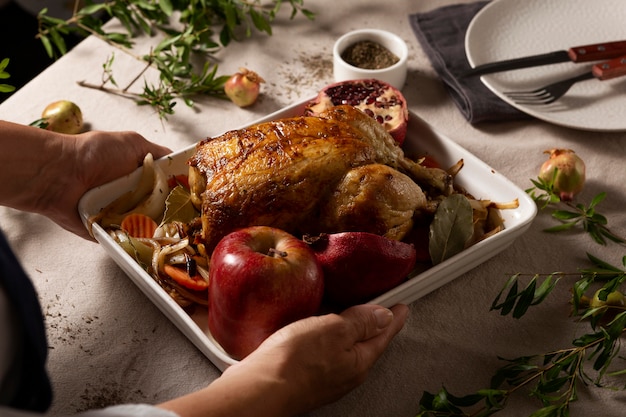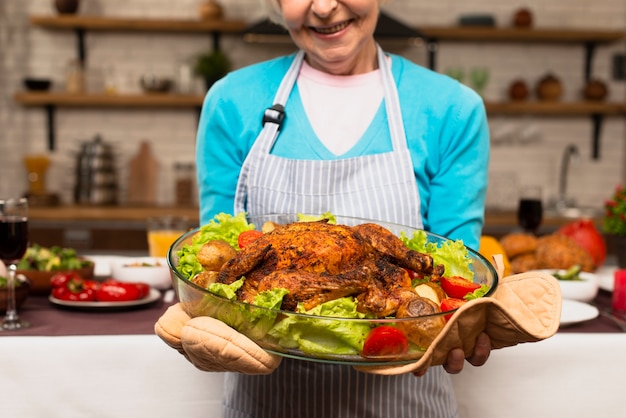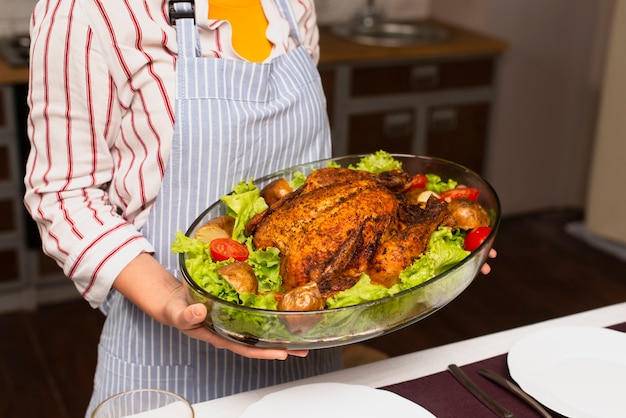As a seasoned cook, I've spent countless hours in the kitchen, experimenting with various techniques to achieve the perfect juicy chicken. From slow roasting to high-heat grilling, I've tried it all. But one constant that always seems to come up in my culinary journey is the oven temperature. The perfect oven temperature for juicy chicken isn't a one-size-fits-all situation; it's a delicate dance between heat, time, and the specific size and cut of the chicken itself.
In this article, I'm going to share my personal experience and insights on finding the ideal oven temperature for juicy chicken. We'll delve into different cooking methods, the factors that influence the perfect temperature, and even some tips and tricks to ensure your chicken is always cooked to perfection. So grab a cuppa, settle in, and let's embark on this delicious journey together.
(Part 1) The Science Behind Juicy Chicken: Understanding Protein Denaturation

Before we dive into specific temperatures, let's understand why oven temperature is so crucial for juicy chicken. It all comes down to protein denaturation. When you cook chicken, the heat causes the proteins to unravel and change their structure. This process is essential for creating the texture and flavor we all love, but it can also lead to dry, tough chicken if not done right.
The Importance of Temperature: Finding the Sweet Spot
The ideal oven temperature allows the chicken to cook evenly without drying out. If the heat is too high, the outside of the chicken will cook too quickly, while the inside remains raw, resulting in a dry, tough exterior with an undercooked center. On the other hand, if the temperature is too low, the chicken will take longer to cook, increasing the risk of overcooking and drying it out.
Factors Affecting Juicy Chicken: More Than Just Heat
Here's where things get interesting. The perfect oven temperature for juicy chicken isn't just about the oven itself. Several factors come into play:
- Size and Cut of Chicken: A whole chicken will take longer to cook than chicken breasts, and a bone-in chicken will take longer than boneless, skinless breasts. Think of it like a puzzle – the more pieces, the longer it takes to put it together.
- Thickness of the Chicken: A thick chicken breast will require a lower temperature than a thin one. Just like a thick steak, it needs more time to cook through evenly.
- Desired Level of Doneness: If you prefer your chicken well-done, you'll need a higher temperature than if you like it slightly pink. It's about finding the balance between safety and your preferred level of tenderness.
- Cooking Method: Roasting requires a lower temperature than baking, and grilling often utilizes high heat. Each method has its own set of rules, and understanding them is crucial for success.
- Oven Type: Different ovens may have slight variations in temperature, so it's always a good idea to use a thermometer to check. It's like calibrating your instrument to ensure you're playing the right notes.
It's like learning a new language; you need to consider the context and adapt your approach.
(Part 2) The Ideal Oven Temperatures for Different Cuts: A Personalized Guide

Now that we understand the fundamentals, let's talk about specific oven temperatures for different cuts of chicken. This is where my personal experience comes in handy. Over the years, I've developed a system based on my own trials and errors, and it seems to consistently deliver juicy and delicious results.
Whole Chicken: A Symphony of Flavor and Tenderness
For a whole chicken, I recommend roasting at 350°F (175°C). This temperature allows for even cooking without drying out the meat. The longer cooking time allows the fat to render and baste the chicken, creating a wonderfully flavorful and juicy result. Imagine the chicken's own juices working their magic, creating a culinary masterpiece.
Chicken Breasts: Achieving Tenderness Without Drying Out
For boneless, skinless chicken breasts, I usually bake them at 375°F (190°C). This temperature ensures a quick and even cook, preventing the breasts from becoming dry. Remember, thinner breasts will cook faster, so adjust the cooking time accordingly. It's like finding the right tempo for a musical piece, adjusting to the rhythm of the ingredients.
chicken thighs: The More Forgiving Cut
Chicken thighs are more forgiving than breasts, as they contain more fat. For bone-in thighs, I bake them at 350°F (175°C) to allow for maximum tenderness and juiciness. If you're using boneless, skinless thighs, you can bump up the temperature to 375°F (190°C). It's like giving the thighs a little more freedom to shine, with a slightly higher temperature enhancing their natural flavor.
chicken wings: Crispy on the Outside, Tender on the Inside
Chicken wings are best cooked at a higher temperature, around 400°F (200°C), to achieve that crispy skin. However, if you prefer a more tender and juicy result, you can roast them at 350°F (175°C) for a longer time. It's all about finding the right balance between texture and taste, a delicate art in the culinary world.
(Part 3) Cooking Methods and Temperatures: Tailoring Your Approach

The oven temperature you choose will also depend on the cooking method you're using. Each method has its own set of guidelines and considerations.
Roasting: A Classic for Whole Chicken and Large Pieces
Roasting is my preferred method for cooking whole chicken or large pieces, as it allows for even cooking and tender results. For a whole chicken, I always start at 350°F (175°C). However, if you want a crispier skin, you can increase the temperature to 400°F (200°C) for the last 30 minutes of cooking. It's like adding a final flourish to a masterpiece, enhancing the visual appeal and texture.
Baking: Perfect for Smaller Pieces
Baking is a great option for cooking smaller pieces of chicken, such as breasts, thighs, or drumsticks. I generally bake them at 375°F (190°C), but you can adjust the temperature depending on the thickness and desired level of doneness. It's about finding the right tempo for each piece, ensuring they cook evenly without drying out.
Grilling: High Heat for a Smoky Flavor
grilling chicken requires high heat to create that lovely char and grill marks. I typically grill chicken at 400°F (200°C) or higher, but it's crucial to monitor the temperature closely to prevent burning. It's like a controlled fire, ensuring the chicken gets that beautiful char without turning into ashes.
(Part 4) Tips and Tricks for Juicy Chicken: Elevate Your Game
Apart from choosing the right oven temperature, there are a few tips and tricks I've picked up over the years that can make all the difference in achieving juicy chicken.
Brining: A Secret Weapon for Tenderness
Brining is a fantastic way to add moisture and flavor to your chicken. It involves soaking the chicken in a salt water solution for a certain amount of time. This helps to tenderize the meat and prevent it from drying out during cooking. It's like giving the chicken a refreshing bath before putting it in the oven, making it plump and juicy.
Using a Thermometer: The Key to Perfect Doneness
The best way to ensure your chicken is cooked through without drying out is to use a meat thermometer. Insert the thermometer into the thickest part of the chicken, and make sure it reaches an internal temperature of 165°F (74°C). It's like checking the temperature of a delicate instrument, ensuring it's playing the right note for perfect doneness.
Resting the Chicken: Allow the Juices to Redistribute
After removing the chicken from the oven, allow it to rest for 10-15 minutes before carving. This gives the juices a chance to redistribute throughout the meat, resulting in a more tender and flavorful chicken. It's like giving the chicken a moment to breathe and settle after its culinary journey.
Basting: Enhancing Flavor and Moisture
Basting your chicken with butter, oil, or pan juices during cooking helps to keep it moist and flavorful. You can baste with a brush or spoon, making sure to evenly distribute the liquid over the entire surface. It's like a gentle massage, adding moisture and enhancing the chicken's flavor profile.
Using a dutch oven: Even Heat Distribution for Perfect Results
A Dutch oven is a great tool for roasting chicken, as it allows for even heat distribution and creates a moist environment for cooking. If you're using a Dutch oven, you can start the chicken at a higher temperature and then lower it for the remaining cooking time. It's like a culinary cocoon, providing the perfect environment for the chicken to cook to perfection.
(Part 5) The Importance of Consistency: A Steady Hand in the Kitchen
I've learned over the years that consistency is key when it comes to cooking chicken. It's not just about picking the right oven temperature; it's about following a consistent routine and paying attention to the little details. For instance, always preheat your oven to the desired temperature, ensure the chicken is evenly coated with seasoning, and check the doneness using a thermometer. It's like a symphony, each instrument playing its part in harmony to create a delicious masterpiece.
Trust Your Instincts: An Essential Part of the Process
While following guidelines is important, don't be afraid to trust your instincts. If the chicken looks like it's browning too quickly, lower the temperature. If it feels dry, baste it with some liquid. It's about learning to adjust your approach based on the specific situation. It's like being a conductor, guiding the orchestra with your intuition and experience.
Don't Be Afraid to Experiment: The Joy of Culinary Exploration
One of the best ways to find the perfect oven temperature for juicy chicken is to experiment. Try different methods, temperatures, and cooking times to see what works best for you and your preferences. There's no right or wrong answer, as long as the chicken is cooked to perfection and tastes delicious. It's like exploring a culinary landscape, discovering new flavors and textures along the way.
(Part 6) Overcoming Common Challenges: A Guide to Troubleshooting
Even with all these tips, you might encounter some challenges along the way. But don't worry, I've got you covered. Here are some common problems and solutions.
Dry Chicken: Identifying and Fixing the Issue
If your chicken is dry, it's probably because it was cooked at too high a temperature or for too long. To prevent this, lower the oven temperature or shorten the cooking time. You can also try brining the chicken before cooking to add moisture. It's like a balancing act, ensuring the chicken doesn't get overcooked and dry.
undercooked chicken: Ensuring food safety
Undercooked chicken is a serious food safety risk. Always use a meat thermometer to ensure the chicken has reached an internal temperature of 165°F (74°C). If the chicken is undercooked, return it to the oven and cook until it reaches the safe temperature. It's like a safety checkpoint, ensuring the chicken is cooked to a safe and delicious standard.
Unevenly Cooked Chicken: Preventing Inconsistency
If your chicken is unevenly cooked, it's likely due to overcrowding in the oven or the chicken pieces being of different sizes. To prevent this, make sure there's enough space between the chicken pieces, and cook smaller pieces separately from larger ones. It's like a culinary orchestra, ensuring each instrument plays in harmony for a perfect melody.
(Part 7) The Joy of Juicy Chicken: A Culinary Masterpiece
There's something truly special about a perfectly cooked piece of chicken. It's a symphony of flavors and textures, from the crisp skin to the tender, juicy meat. And it's a testament to the art of cooking. It's like a masterpiece, and the right oven temperature is like the perfect brushstroke.
Sharing the Joy: Connecting Through Food
The joy of juicy chicken is even greater when you share it with loved ones. It's a dish that brings people together, sparking conversations and creating lasting memories. It's a reminder of the simple pleasures in life and the power of food to connect us. It's like a shared experience, a common thread that binds us together.
A culinary adventure: Embracing the Journey
Cooking juicy chicken is more than just a recipe; it's an adventure. It's a journey of discovery, learning, and experimentation. It's a chance to push your boundaries, hone your skills, and create something truly delicious. It's like a quest, exploring different techniques and ingredients to find your own perfect recipe.
(Part 8) FAQs: Answering Your Burning Questions
1. What is the best way to check if chicken is cooked through?
The best way to check if chicken is cooked through is to use a meat thermometer. Insert the thermometer into the thickest part of the chicken, and make sure it reaches an internal temperature of 165°F (74°C). It's like a precise measurement, ensuring the chicken is cooked to perfection without any guesswork.
2. Can I cook chicken at a lower temperature for longer?
Yes, you can cook chicken at a lower temperature for longer. This is especially beneficial for larger pieces of chicken, as it allows for more even cooking and prevents drying out. It's like a slow simmer, allowing the chicken to cook gently and evenly.
3. What should I do if my chicken is dry?
If your chicken is dry, you can try adding some liquid to the pan, such as broth, wine, or even water. You can also baste the chicken with pan juices or butter. It's like adding a touch of hydration, restoring the moisture and flavor to the chicken.
4. What are some good side dishes for chicken?
Some classic side dishes for chicken include mashed potatoes, roasted vegetables, rice, and salads. It's like creating a harmonious blend of flavors and textures, complementing the juicy chicken perfectly.
5. How can I prevent my chicken from sticking to the baking sheet?
To prevent chicken from sticking to the baking sheet, make sure to grease it well before adding the chicken. You can also use parchment paper or a silicone baking mat. It's like creating a nonstick surface, ensuring the chicken cooks evenly and releases easily.
(Part 9) Final Thoughts: Embracing the Journey
Finding the perfect oven temperature for juicy chicken is a journey, not a destination. It's a process of learning, experimenting, and adapting. But with a little practice and these tips, you'll be able to consistently cook delicious and juicy chicken that will leave everyone wanting more. It's like a constant evolution, refining your skills and expanding your culinary repertoire.
So next time you're craving a juicy, flavorful chicken dish, remember these insights. It's not just about the oven temperature; it's about the passion, the care, and the joy you put into your cooking. Happy cooking!
Everyone is watching

Perfect Rice Every Time: The Ultimate Guide to Cooking Rice
Cooking TipsAs a self-proclaimed foodie, I've always been a bit obsessed with rice. It's the foundation of countless cuisi...

Prime Rib Roast Cooking Time Chart: Per Pound Guide
Cooking TipsPrime rib roast. Just the name conjures images of lavish dinners, crackling fires, and hearty laughter. It’s ...

The Ultimate Guide to Cooking Asparagus: Tips, Techniques, and Recipes
Cooking TipsAsparagus. The mere mention of this spring delicacy conjures up images of vibrant green spears, crisp and burs...

Ultimate Guide to Cooking the Perfect Thanksgiving Turkey
Cooking TipsThanksgiving. Just the word conjures up images of overflowing tables laden with delicious food, the scent of r...

How Long to Bake Potatoes in the Oven (Perfect Every Time)
Cooking TipsBaked potatoes are a staple in my kitchen. They're incredibly versatile, delicious, and surprisingly easy to m...
